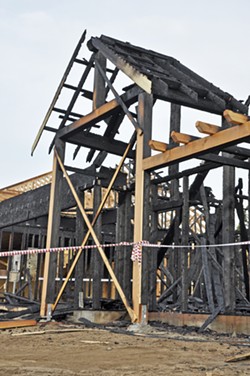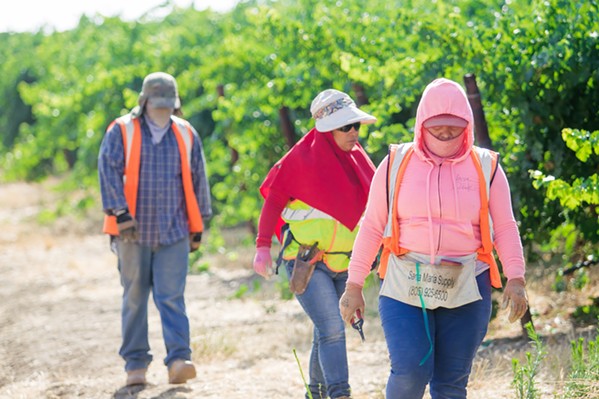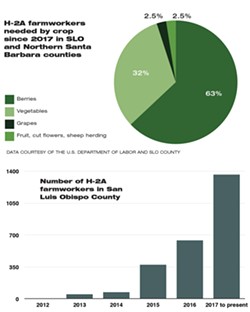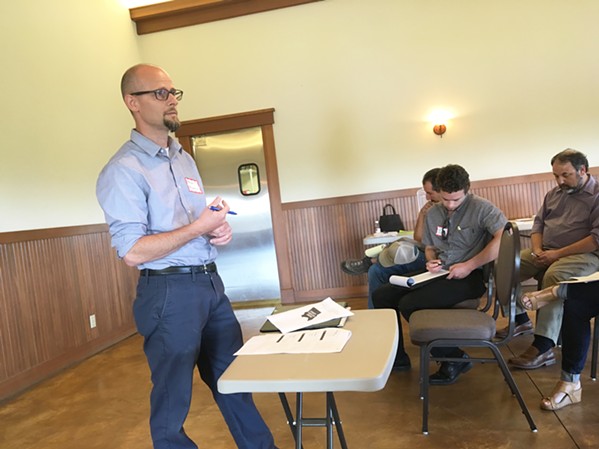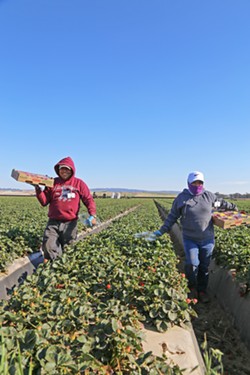[{
"name": "Ad - Medium Rectangle CC01 - 300x250",
"id": "AdMediumRectangleCC01300x250",
"class": "inlineCenter",
"insertPoint": "8",
"component": "2963441",
"requiredCountToDisplay": "12"
},{
"name": "Ad - Medium Rectangle LC01 - 300x250",
"id": "AdMediumRectangleCC01300x250",
"class": "inlineCenter",
"insertPoint": "18",
"component": "2963441",
"requiredCountToDisplay": "22"
},{
"name": "Ad - Medium Rectangle LC09 - 300x250",
"id": "AdMediumRectangleLC09300x250",
"class": "inlineCenter",
"insertPoint": "28",
"component": "3252660",
"requiredCountToDisplay": "32"
}]
More than two years have passed, but the image is still fresh in the collective consciousness of the San Luis Obispo County agricultural community: The anger and threats that led to a destructive fire and then, ultimately, the abandonment of seven homes in Nipomo. They were nearly ready to house 112 foreign strawberry field workers on temporary visas—until someone decided put a match to it.
The arson occurred on April 6, 2016, at the height of an intense swell of neighborhood opposition to the development on the residential cul-de-sac, Mads Place. Shaken by the experience, property owners Greg and Donna France of Mar Vista Berries abandoned the project. Authorities haven't identified a suspect, and their investigation is ongoing, according to Cal Fire.
Twenty-eight months after the France's project went up in flames (note: only one home went up in literal flames), the lack of farmworker housing in SLO County remains an unresolved issue for many growers and field workers.
"Really, nothing has been done since [the fire]," said 4th District SLO County Supervisor Lynn Compton, who represents Arroyo Grande, Oceano, and Nipomo, where berries and vegetables are heavily farmed. "[Farmworkers] come up here, and they don't have anywhere to live."
The farmworker housing shortage links directly with the general farm labor shortage, which continues to impact the local ag industry: Vegetable production levels hit a 35-year low in the county in 2017. While housing is a critical need, with the number of H-2A visa workers roughly doubling in the last two years, the Mads Place incident lingers as a chilling example of a failed attempt to place legal foreign farmworkers next to resistant local residents. In the meantime, the same workers plucking berries and pruning wine grape vines in SLO County are often commuting to the area from surrounding regions, like the Santa Maria, Salinas, or Central valleys, according public visa documents and local growers who spoke with New Times
In the wake of the arson, the SLO County Board of Supervisors allocated $250,000 to examine what the county can do to help alleviate the farmworker housing crunch. After holding workshops with local stakeholders, county officials will present a series of potential policy solutions on Aug. 21 that may get the ball rolling.
Root of the problem
The 2011 statewide drought initially masked the extent of the labor problem. Because crops require water before they require the labor to harvest them, farmers like Tom Ikeda, a longtime grower in the Pismo Oceano Vegetable Exchange, didn't feel the labor pinch as acutely in 2012 as he did in 2016.
"The drought kind of hid the problem because people were fallowing ground," Ikeda said. "Since they didn't have as much ground in production, the need for labor work wasn't as great, so they were able to get by. But two winters ago, when we had the good rain, people had the water to plant up that fallow ground, and that's when things really started to come to a head."
Throughout California the domestic farm labor force is on the decline, as the previous generation of immigrant field workers is aging and not being replaced by a new wave of immigrant workforce. Tavo Acosta, who manages vineyards from San Miguel to Los Alamos for Vino Farms, has observed this shift take place firsthand.
"There was a certain time a few years ago when border crossing just became so hard and dangerous. So the risk, with everything added to it, is not worth it for new [workers] to take," Acosta said. "There's no filling-in for a labor force that is getting older."
Additionally, the children of first-generation farmworkers are often choosing a life and career outside of agriculture.
"Like any other parent, they want the best for their kids," Acosta said. "Their kids try [farming] out to get through high school and college, but after that, there's no continuance from there. ... I think there's a strive for betterment."
The dwindling availability of local labor has caused a strain for farming operations—but the level of impact varies by the crop. In the last few years, vegetable farmers like Ikeda have watched roughly 20 percent of their would-be harvest rot in the fields due to lack of labor. When the market is tight, the higher value crops like strawberries and grapes tend to attract the workers. Berries, especially, can pay significantly more with "piece rate" wages that go up with a fast picker. And most wine grapes can now be harvested with machines, which reduces vintners' need.
"In vegetables, it's not whole fields that we lose; it's percentages," Ikeda said. "Each field, we have a certain [time] window to harvest because it's a perishable product. In the industry, I've heard similar stories and questions: 'OK, what are we going to do? How are we going to get through this?' Everybody's asking the same questions."
While some crops are faring better than others with the labor shortage, most are having to turn to a burgeoning federal visa program to supplement their workforce with temporary foreign labor.
Shifting to H-2A
In 2012, farmers in SLO County filed zero applications with the U.S. Department of Labor (DOL) to utilize the H-2A visa program, which enables growers to hire temporary foreign workers to fill their labor needs. By 2016, local growers had requested about 650 H-2A workers per year. Between January 2017 and July 2018, a 19-month period, the number had grown to about 1,300 H-2A workers, according to a New Times analysis of DOL data.
The growing local reliance on the H-2A program mirrors the trend that's seen statewide in agriculture, where the number of H-2A workers in California has exploded from a low of fewer than 2,000 in 2011 to more than 14,000 in 2017, according to an LA Times count.
And it all points back to the local farmworker shortage.
"We're not 100 percent H-2A for our harvest, but our percentage is increasing because the domestic labor force just isn't there," Ikeda said.
Strawberry farmers call for the most H-2A workers, accounting for almost two-thirds of all the H-2A workers in SLO and Northern Santa Barbara counties since 2017. Vegetables demanded about a third, and grapes, fruits, cut flowers, and sheep herding made up the remaining workers.
Acosta, of Vino Farms, said his vineyard operations are just starting to dip their toes in the H-2A program.
"We think that's going to be a growing angle for us," he said. But the biggest hurdle to making the H-2A program function is housing. Under H-2A regulations, the employer must provide the workers housing, food, and transportation throughout their stay, which can be for up to a year. As the need for H-2A workers grows, those requirements have become a substantial roadblock for farmers up and down the Central Coast, raising questions for local governments about where such housing, which is higher-density by nature, can be accommodated and whether their communities can tolerate it.
Housing hurdles
Before the arson, as the debate raged in Nipomo over the Mads Place H-2A project—seven houses, 16 workers per house—Supervisor Compton voiced her opposition to the concept. It was a conflict of land uses, she said; H-2A housing would be better suited closer to the field site and not next to residential homes.
"I have said early on that I wouldn't want a sorority next to me, with the noise and stuff like that," Compton told New Times in early August. "I'm not sure that's appropriate in a residential area."
Exactly where H-2A housing should go in SLO County is the question policy makers will have to answer. Many SLO farmers currently depend on surrounding communities to do the heavy lifting on H-2A housing; Santa Maria houses a large percentage of SLO's H-2A workers, according to DOL applications. Ultimately, that creates a crunch for housing units, additional expenses for farmers to bus their workers to and from the job sites, and ongoing environmental impacts.
"I think one of the biggest obstacles for this program to flourish is the ability to house the employees," Acosta said. "It's a stumbling block for allowing this great program that is needed to actually be able to unfold itself."
SLO County planners have started their search for solutions by looking at the county's existing farmworker housing ordinance. Under the ordinance, the county's issued 110 building permits, most of which were for single-family homes incapable of housing large groups of people. The ordinance includes rules and restrictions that the ag community believes are hindering new housing opportunities.
"The current regulations just don't fit to today's situation," said Ikeda, of the Pismo Oceano Vegetable Exchange. "It wasn't developed in a time with this type of situation in mind. It wasn't to this scale."
Current rules require any "group quarters"-style farmworker housing to be located within 5 miles of the agricultural site where its occupants work. Brian Pedrotti, a senior SLO County planner, told New Times that the feedback he hears from farmers is the 5-mile requirement isn't realistic given the way labor migrates up and down the coast for work.
"Farmworker labor is sort of a regional type of industry," Pedrotti said. "There's a lot of back and forth between Monterey County and Ventura County and down farther south and farther north—there's a lot of movement of farmworker labor. So [we're] looking at a larger area that you could justify the number of farmworker units on your property."
Loosening density and occupancy limits, minimum site acreage sizes, permit requirements, and zoning restrictions are also on the table for county supervisors to consider on Aug. 21. Farmworker housing, as defined by the county, is currently only allowed on ag and rural lands zones—those zones could expand to residential rural, for instance. Another archaic provision is that single-family-style homes built as farmworker housing can't be occupied by seasonal farmworkers, only full-time employees.
Generally speaking, SLO County's farmworker housing regulations are more restrictive than other coastal agricultural counties in California. Compton said the red tape for constructing units is frustrating for the growers she talks to in her South County district.
"You have some growers that are interested, and it seems like we run into a brick wall every time they want to do something," she said.
While H-2A housing is the recent focus of farmers and communities, it's far from the only type of farmworker housing that's needed. Lynn Diehl, executive director of the SLO County Farm Bureau, noted that housing is a challenge for all agricultural industry employees.
"It is not simply H-2A or field labor, but also workers who may be middle managers and longtime employees," Diehl told New Times.
A recent survey published by a coalition of agencies in the Salinas and Pajaro valleys addressed the wide-ranging housing needs of farm labor. The study concluded that the region needs more than 45,000 additional units to "alleviate critical overcrowding in farmworker households." It suggested aggressive local action like passing affordable housing bonds in Santa Cruz and Monterey counties as well as leveraging federal, state, and local funds to finance new projects.
Kenneth Trigueiro, vice president of Peoples' Self-Help Housing, said funding is always the challenge when developing low-income housing. For the three farmworker projects that the nonprofit has completed in SLO County—apartment complexes in Oceano, Avila Beach, and Paso Robles—it received financing from a pool of state farmworker housing funds that were, in part, generated by Proposition 1C passed in 2006. Those funds are nearly gone, Trigueiro said. He asked that voters support Proposition 1 on the upcoming November ballot, a bond that will replenish California's affordable housing coffers with $4 billion.
"That will get the resources back for farmworker housing and all the other programs that we're utilizing for low-income families," Trigueiro said.
Uncertain future
As farmers scramble to adapt to the drastic shift in the labor market toward the H-2A program, they're simultaneously trying to bring communities up to speed on the facts of what it is.
H-2A workers are legal. They're vetted with background checks and security clearances from a U.S. consulate. They're monitored by the employer and transported in carpools via van, shuttle, or bus to the fields. They're not seeking citizenship in the U.S. They're not looking to get in trouble.
Carlos Castaneda, of Castaneda & Sons, a labor contracting company for about a dozen local growers, described the opportunity of H-2A as a "golden ticket" for the worker. A young man in Mexico making a few dollars an hour in his home country is given the chance to make six times that in the U.S. for a few months. It's money that he can bring back to support his family. That's not an opportunity most people want to screw up.
But the message isn't always heard by local residents, as was the case at Mads Place in Nipomo in 2016. Concerns about increased criminal activity, traffic, and general disruptiveness are often expressed. And such opposition is likely going to continue as the push for housing carries on.
"I don't think [those fears are] quite necessarily what is happening," Acosta said. "This migrant worker is here to work. They are very much embedded in their home country, and they're screened intensively before they come."
While the H-2A program can at times be a clash between farmers and locals, in the big picture, it's not really that black and white. Ikeda doesn't see the H-2A phenomenon as a rosy sign for the future of his industry. The bottom line is farm labor is going away, and that reality is leaving farmers at a crossroads.
"We've pretty much been forced to go to H-2A labor, but in doing that, it comes at a higher cost," Ikeda said. "The higher cost trickles down to domestic labor, so that labor becomes more expensive. In turn, the rate for next year's H-2A [workers] is based on the prevailing wages of the region, which is going up because of H-2A.
"So it's kind of a vicious cycle, and there's going to come a point in time when we can't afford to do this," he continued. "I think everybody sees that this is not a sustainable model." Δ
Assistant Editor Peter Johnson can be reached at [email protected].
Latest in News
Comments
Showing 1-1 of 1
Readers also liked…
-

Coast Unified teachers upset over new position's salary and qualifications
Oct 20, 2022 -

SLO police identify alleged driver who hit and killed couple
Dec 22, 2022 -

When the levee breaks: Oceano residents, county officials walk a tightrope of regulations to manage Arroyo Grande Creek, which some say led to the levee's failure in January
May 18, 2023

